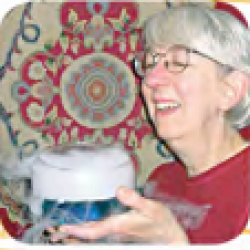Source Institutions
Source Institutions
Add to list Go to activity
Activity link broken? See if it's at the internet archive

In this activity on page 8 of the PDF (Behind the Scenes with Chemistry), learners make three of Harry Potter's essential school supplies: quills, ink, and color-changing paper. Learners use supplies from the grocery store to make ancient iron tannate ink (permanent), color-changing paper, and a feather quill pen. Safety notes: Wear eye protection and be careful with hot liquids. The ink is permanent and will stain clothes. Follow Milli's safety tips on page 3 of the PDF.
- Under 5 minutes
- 1 to 7 days
- $10 - $20 per student
- Ages 8 - 14
- Activity, Experiment/Lab Activity
- English, Spanish
Quick Guide
Materials List (per student)
- 2 mugs, teacups, or small glass bowls
- 1 tea bag (black tea)
- Boiling water and an adult helper
- 1 iron sulfate (ferrous sulfate) tablet
- A mortar and pestle or a small glass bottle
- A measuring cup
- A small storage container, like a pill bottle, with label
- A strainer
- Hot tap water
- Purple cabbage
- Plain white paper (8 1/2 in x 11 in)
- A blender and an adult helper
- A labeled storage container, quart-size
- A big, flat pan (9 in x 13 in is a good size)
- Newspapers or plastic sheet to cover work area
- Vinegar
- Baking soda
- Lemon juice
- Cotton swabs or wooden skewers
- Large turkey feather
- Bowl of warm water
- Small scissors
Subjects
-
Life Sciences
-
Diversity of Life
- Plants
-
Diversity of Life
-
Physical Sciences
-
Heat and Thermodynamics
- Heat and Temperature
-
Chemistry
- Chemical Reactions
- Acids and Bases
- Oxidation-Reduction Reactions
- Solutions
-
Vibration and Waves
- Light and Optics
-
Light and Optics
- Sunlight and Color
-
States of Matter
- Solids
- Liquids
-
Heat and Thermodynamics
-
The Nature of Science
-
The Scientific Process
- Conducting Investigations
- Gathering Data
- Formulating Explanations
- Communicating Results
-
The Scientific Process
-
The Nature of Technology
-
Technology and Society
- Technology and History
-
Technology and Society
Informal Categories
- Arts and Crafts
- Food and Cooking
- Historical Reenactment
- Literature
- Photography and Film/Video
Audience
To use this activity, learners need to:
- see
- see color
- read
- touch
Learning styles supported:
- Links STEM to other topics of interest such as arts and humanities
- Involves hands-on or lab activities
Other
Foreign language versions of this resource:
Access Rights:
- Free access
By:
- Snell Copes, Jane
Rights:
- All rights reserved, American Chemical Society, 2010
